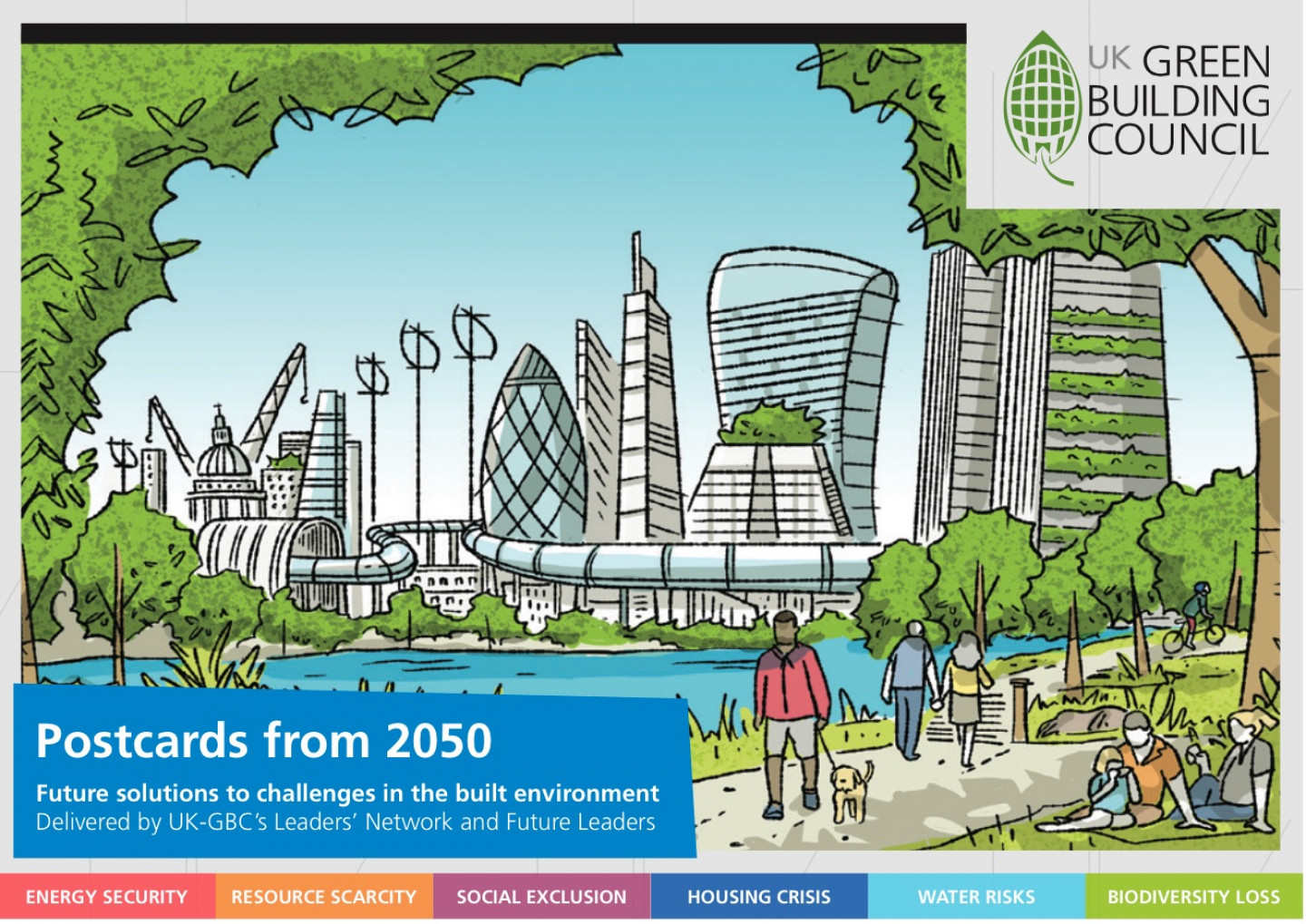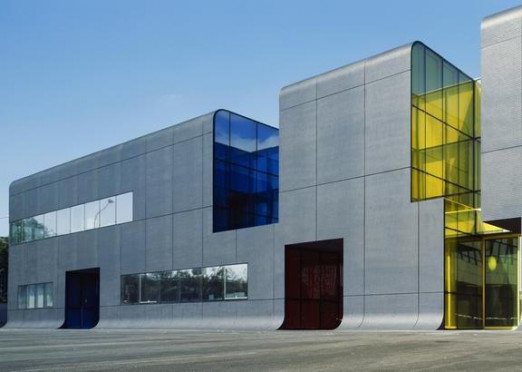Postcards from 2050

(Credit: Scriberia)
Scenarios for the future of the built environment mix the bold and the bracing
“There’s a rather extraordinary story to be discovered in these postcards. Some are written from a 2015 perspective, looking forward; others from 2050, looking back,” writes Jonathan Porritt in his intro to the UK Green Building Council Project Postcards from 2050. “On those 35 years – trust me on this one – rests the entire future of humankind on Planet Earth.”
Covering issues including energy security, social exclusion and biodiversity loss, respondents from the UK-GBC’s Leaders’ Network and Future Leaders tackle some key ideas with imaginative brio.

(Credit: Scriberia)
There are some sobering observations such as those from Anglian Water’s Director of Assett Management Chris Newsome: “The World Economic Forum report for 2015 has made clear that a water supply crisis is the number one risk we face over the next 10 years by impact…”, where water scarcity and flooding will have a very direct impact on building design and construction
Pat Ward, CEO, Aggregate Industries looks at the issue of biodiversity in the construction sector, when in sourcing materials, “land use and the way in which we design and situate buildings will be of particular interest, with a real focus on the loss of green space in urban areas.”
While Lend Lease’s Gemma Bourne looks back from 2050 to the innovative new SmartRent policy launched by the European Union in 2030, “to improve access to affordable housing for Millennials. SmartRent followed a number of already established and successful start-ups from the 2020s and is now the most successful housing investment scheme, socially and financially, in the world.”
A crisply delivered series of ideas that should start a ripple of debate.
To read more and download the project click here

(Credit: Scriberia)
Material of the week: the orange

(Credit: New acoustic insulation material)
Researchers use fibres from orange tree-pruning to improve acoustic insulation
Yes, a pithy slice of research published in The Journal of Construction and Building Materials, by a team at the Universitat Politècnica de València and the Universitat de Girona explains how they used fibres from orange tree-pruning to develop better acoustic insulation boards that delivers a 150% improvement on conventional laminated gypsum boards.
“The mechanical properties are better than those of gypsum boards; this means that with the same board thickness, the acoustic insulation is higher; or that we can reduce the thickness to obtain the same insulation”, says project member Dr. Jesús Alba (below).

Not only does it work better than conventional gypsum boards, it’s more environmentally friendly, delivering on objectives defined in Horizon 2020 (the EU framework for Research and Innovation) which promotes the use of natural or recyclable materials.
Calculating the beauty of concrete

(Credit: Thor Nielsen/SINTEF)
Tool helps classify concrete surface qualitys
If beauty is in the eye of the beholder, it seems that the beauty of concrete is in its pores – or lack of. Researchers at SINTEF (Stiftelsen for Industriell og Teknisk Forskning/The Foundation for Scientific and Industrial Research) have developed a tool to help classify the quality of a concrete surface.
The tool, Betong GUI, uses image analysis to quantify number and size of pores. “A good impression can be spoiled if there are too many pores on what was supposed to be a smooth surface”, explained Project Manager Tone Østnor and Research engineer at the Department of Architecture Materials and Structure. The benefit, they believe is that architect, developer and building contractor can agree beforehand what the end result should look like.
You can download a beta version at SINTEF
Re-building democracy?

(Credit: Jay Morton)
Asbestos, flooding, fire safety issues, the Houses of Parliament are in a state of disrepair. Is the venerable building sending a wider political message?
Widely reported in the mainstream media this week, John Bercow, the speaker of the House, has estimated a realistic cost for the repair of the Houses of Parliament at £3 billion – a large number to swallow for the UK public in times of austerity. Since his announcement, others have suggested that on past performance a £3bn rough estimate could mean £6bn as a final cost.
The Grade I-listed building and part centrepiece of a UNESCO world heritage site, this global icon and popular tourist attraction is in serious disrepair. Indeed The Daily Mail, perhaps inspired by the Gothic drama of the building itself, wrote that “Even the boilers, dating from before the Second World War, are said to be ‘ready to blow’.” There’s also the subsidence, surely not an echo of the current low esteem of the public for politicians, and the tilting of Big Ben’s bell tower.
Simon Jenkins in The Guardian sees it as an opportunity to highlight the revival of provincial England, “Birmingham might bid for Kenilworth, venue of Simon de Montfort’s first Commons, but it would need a huge marquee. Meanwhile the Cromwell of our day, George Osborne, has established Manchester as second city in the land. It is well appointed, with a good airport and two hours by train from London.”
While in the in The Daily Telegraph Conservative MP Michael Fabricant wrote of the value of history and its “contemplative” mood, “I like Westminster. Combative at times, yes. But contemplative and thoughtful too. History keeps us grounded to our founding democratic principles.”
A more radical solution is proposed by Generation Rent, a group “campaigning with private renters for professionally managed, secure, decent and affordable privately rented homes.” Quick off the mark, they suggest moving parliament to Hull and turning the Palace of Westminster into 364 affordable flats, with a design concept by Jay Morton, a specialist in social and affordable architecture.

(Credit: Jay Morton)
On their website Dan Wilson Craw highlights some perhaps extravangant rental issues in the current Palace of Westminster arrangement, "The move would net the taxpayer a windfall of up to half a billion pounds by selling the prestigious riverfront offices of 213 MPs, Portcullis House, and finally end the rental of fig trees for the building that has so far cost taxpayers over £400,000."
But amidst the media coverage, are we missing an opportunity to have a real debate? We know how the built environment shapes behaviour and psychology – surely this is a chance for a debate on the kind of building, or buildings we want that will reflect, generate, inspire a new politics for the 21st Century.
If politicians are seen as being out of touch, perhaps we need an architecture that is open and invites dialogue, conversation and creative argument. When the public’s faith in institutional politics and democracy is at such a low ebb, this venerable old building, the ‘Mother of Parliaments’ is telling us that we need a newer more vital political space.
Topping Out, Building Centre Editor, John O'Reilly

